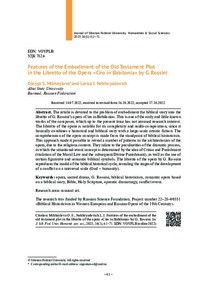Особенности воплощения ветхозаветного сюжета в либретто оперы «Кир в Вавилоне» Дж. Россини
Автор:
Михайлова, О. С.
Нехвядович, Л. И.
Mikhaylova, Olesya S.
Nekhvyadovich, Larisa I.
Дата:
2022-12Журнал:
Журнал Сибирского федерального университета. Гуманитарные науки. Journal of Siberian Federal University. Humanities & Social Sciences; 2023 16 (1)Аннотация:
Статья посвящена проблеме воплощения библейского сюжета
в либретто оперы Дж. Россини «Кир в Вавилоне». Это одно из ранних
и малоизвестных произведений композитора, которое вплоть до настоящего
времени не вызывало исследовательского интереса. Либретто оперы отличается
сложностью и многосоставностью, поскольку объединяет в своей основе историко-библейский
сюжет с масштабным художественным вымыслом. Осмысление
оперной концепции производится с позиций библейского историзма. Такой подход
позволил выявить в архитектонике оперы ряд закономерностей, обусловленных
религиозным содержанием. Они касаются особенностей драматургического процесса,
в котором ситуационно-событийная
концепция определяется идеей Преступления
и Наказания (нарушение Нравственного закона и последующая Божья кара), а также
использования определенной образно-смысловой
библейской символики. В либретто
оперы Дж. Россини воспроизводится модель библейского исторического цикла,
раскрывающая этапы развития конфликта вселенского масштаба (Бог – человечество) The article is devoted to the problem of embodiment the biblical story into the
libretto of G. Rossini’s opera «Ciro in Babilonia». This is one of the early and little-known
works of the composer, which up to the present time has not aroused research interest.
The libretto of the opera is notable for its complexity and multi-composition,
since it
basically combines a historical and biblical story with a large-scale
artistic fiction. The
comprehension of the opera concept is made from the standpoint of biblical historicism.
This approach made it possible to reveal a number of patterns in the architectonics of the
opera, due to the religious content. They relate to the peculiarities of the dramatic process,
in which the situational-event
concept is determined by the idea of Crime and Punishment
(violation of the Moral Law and the subsequent Divine Punishment), as well as the use of
certain figurative and semantic biblical symbols. The libretto of the opera by G. Rossini
reproduces the model of the biblical historical cycle, revealing the stages of the development
of a conflict on a universal scale (God – humanity)

